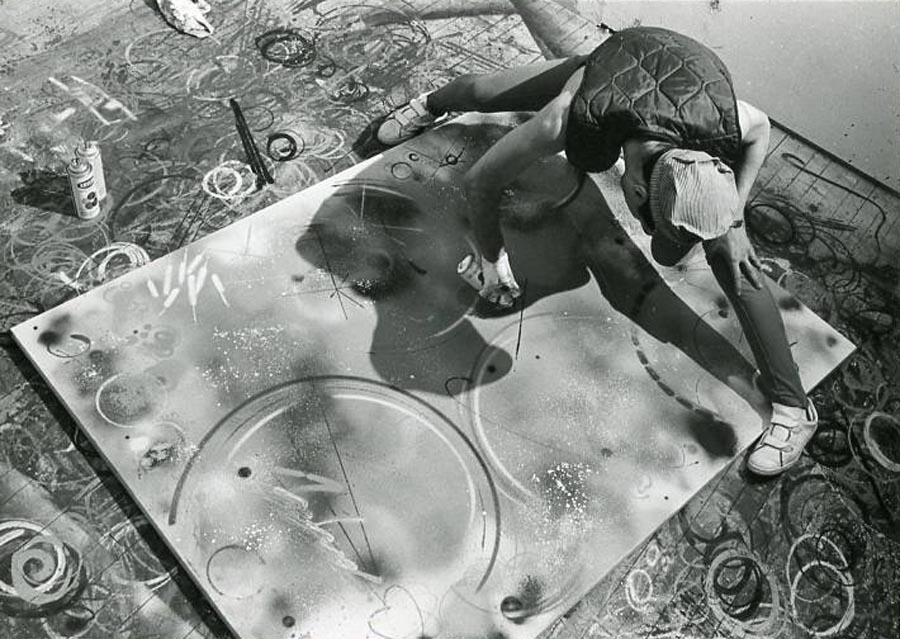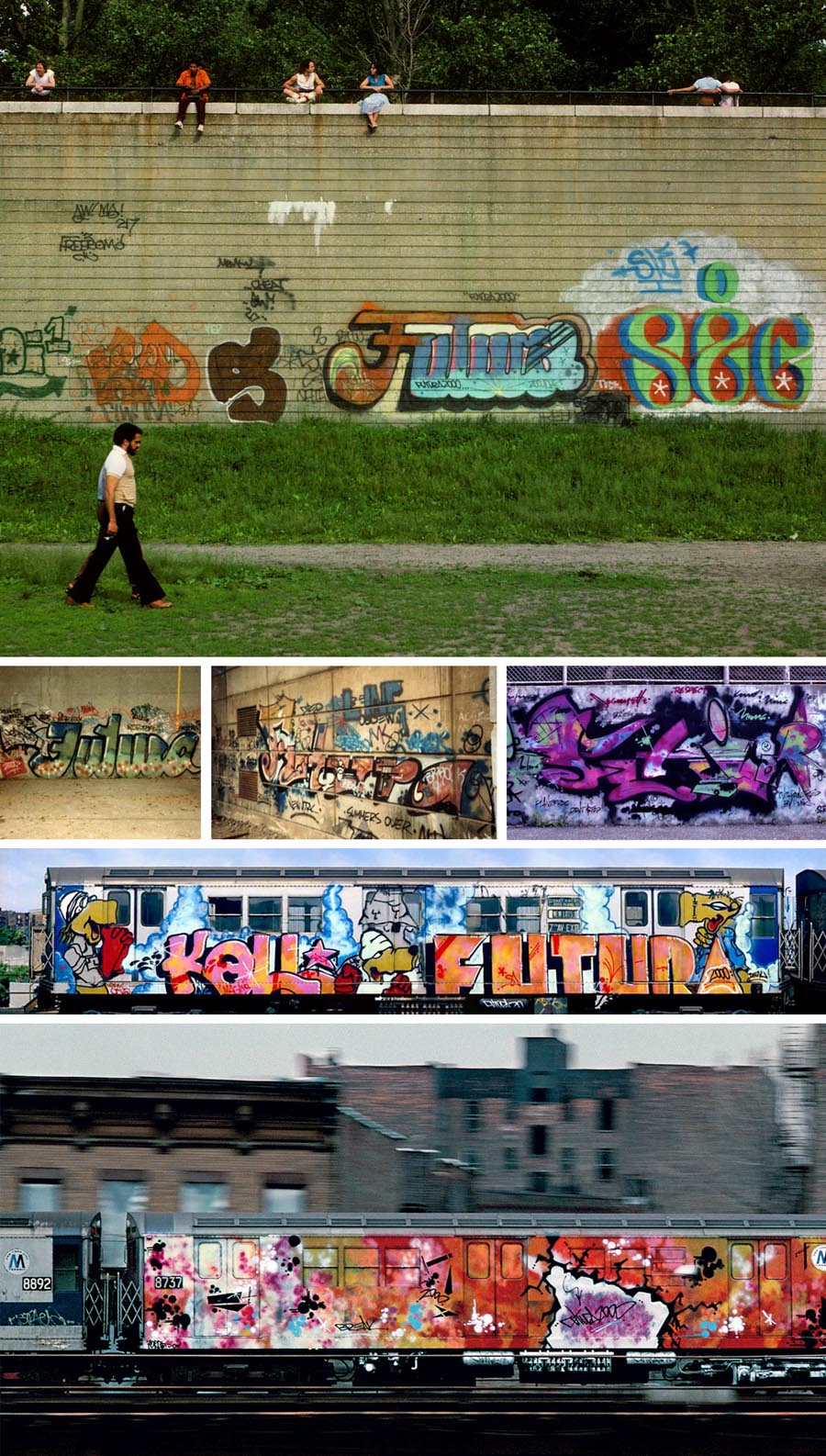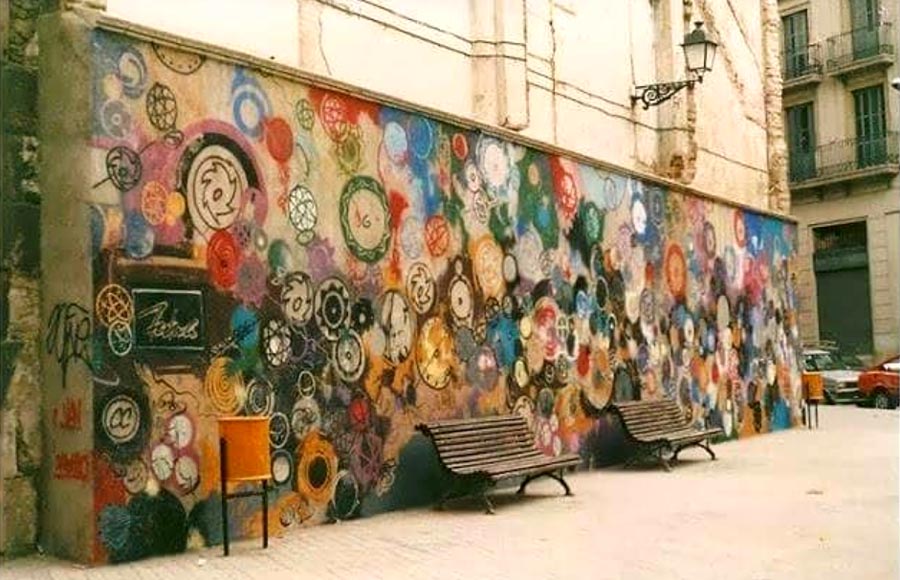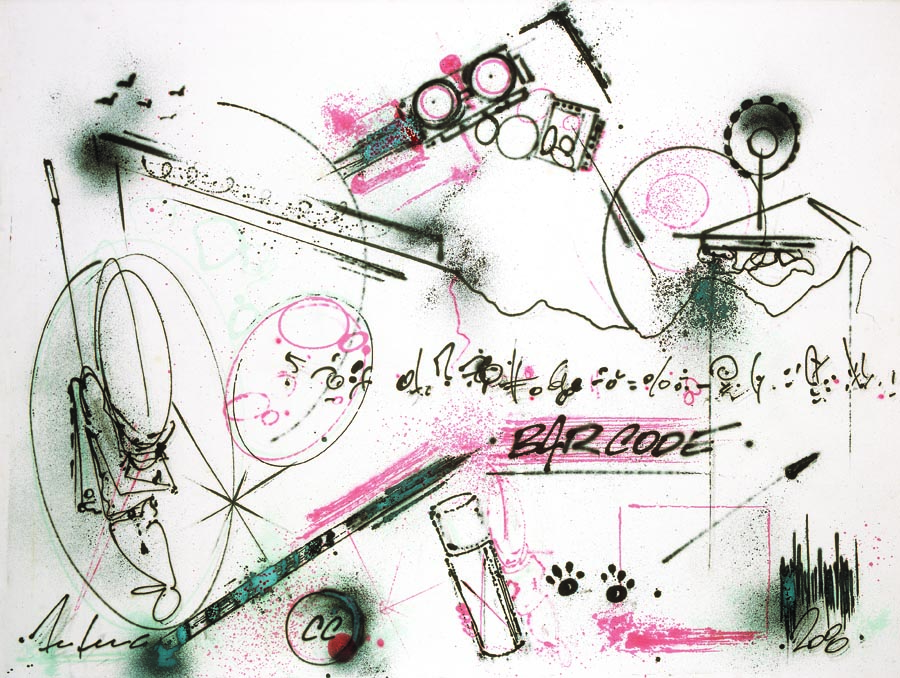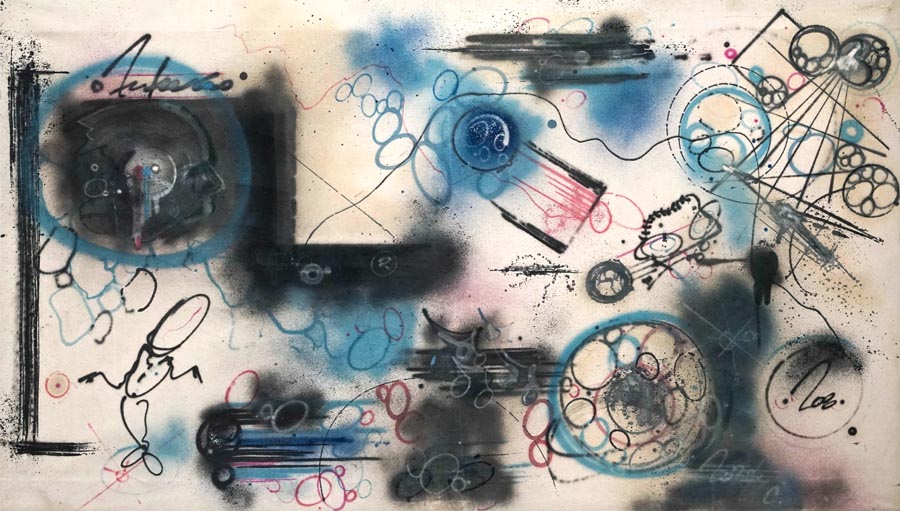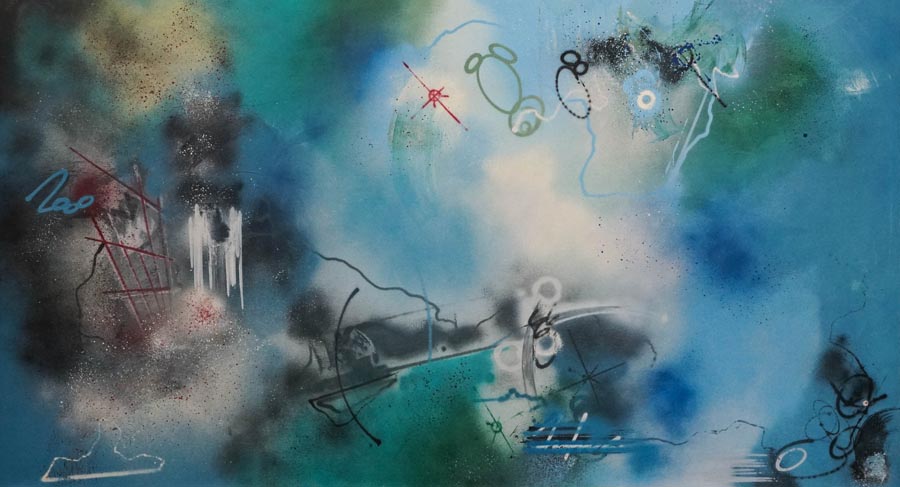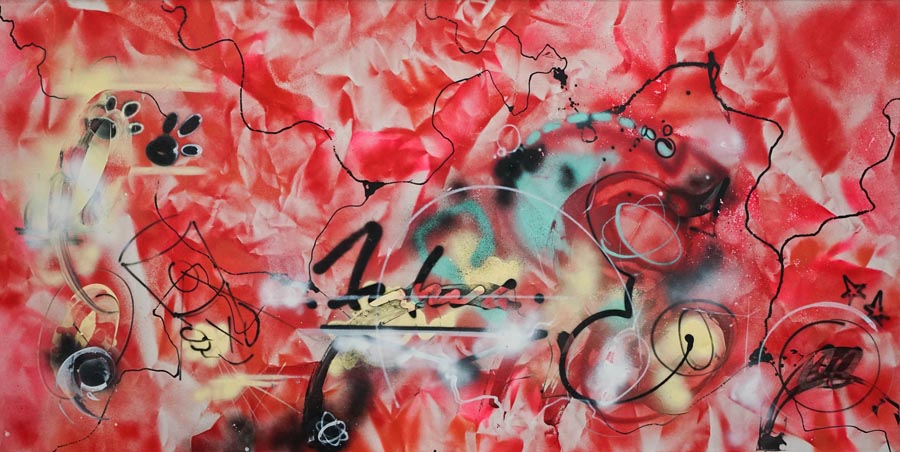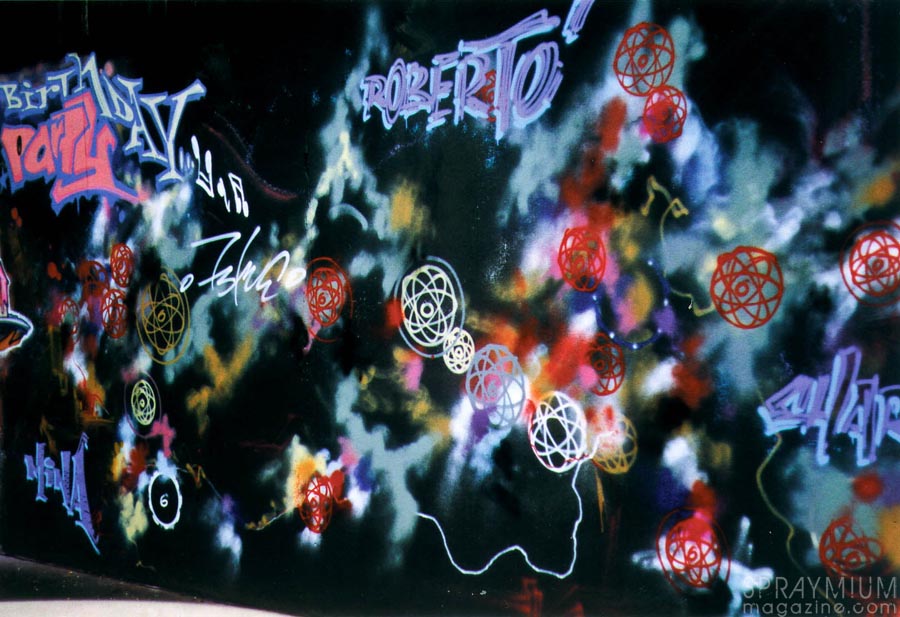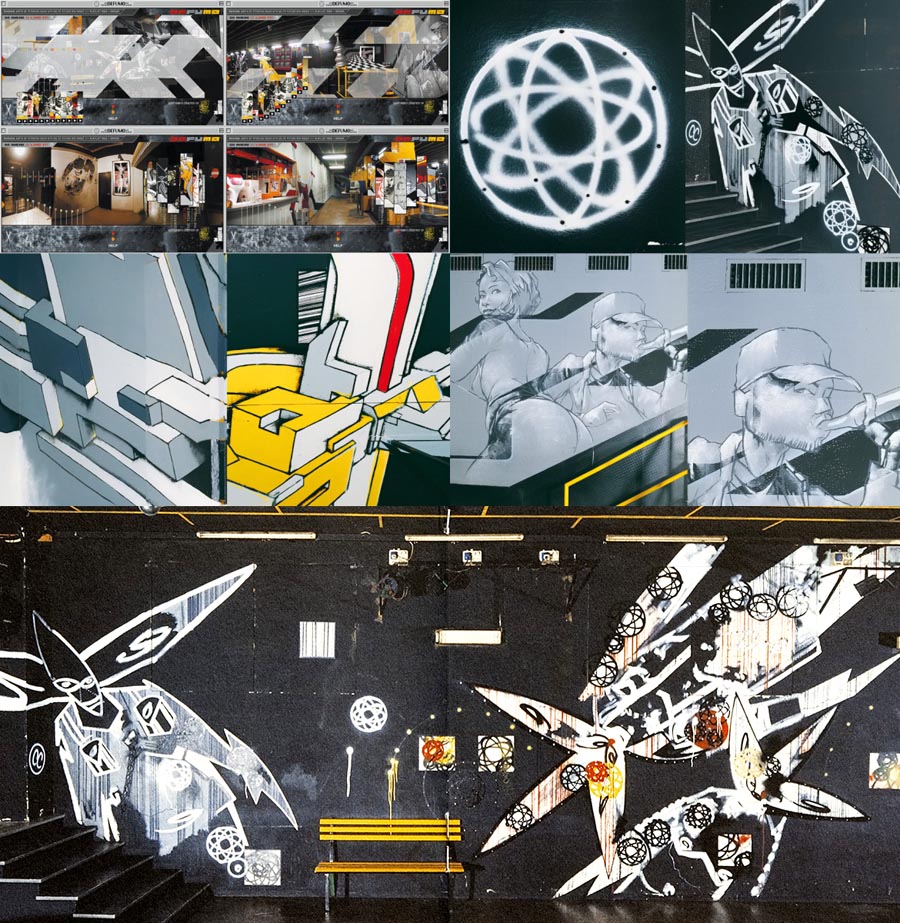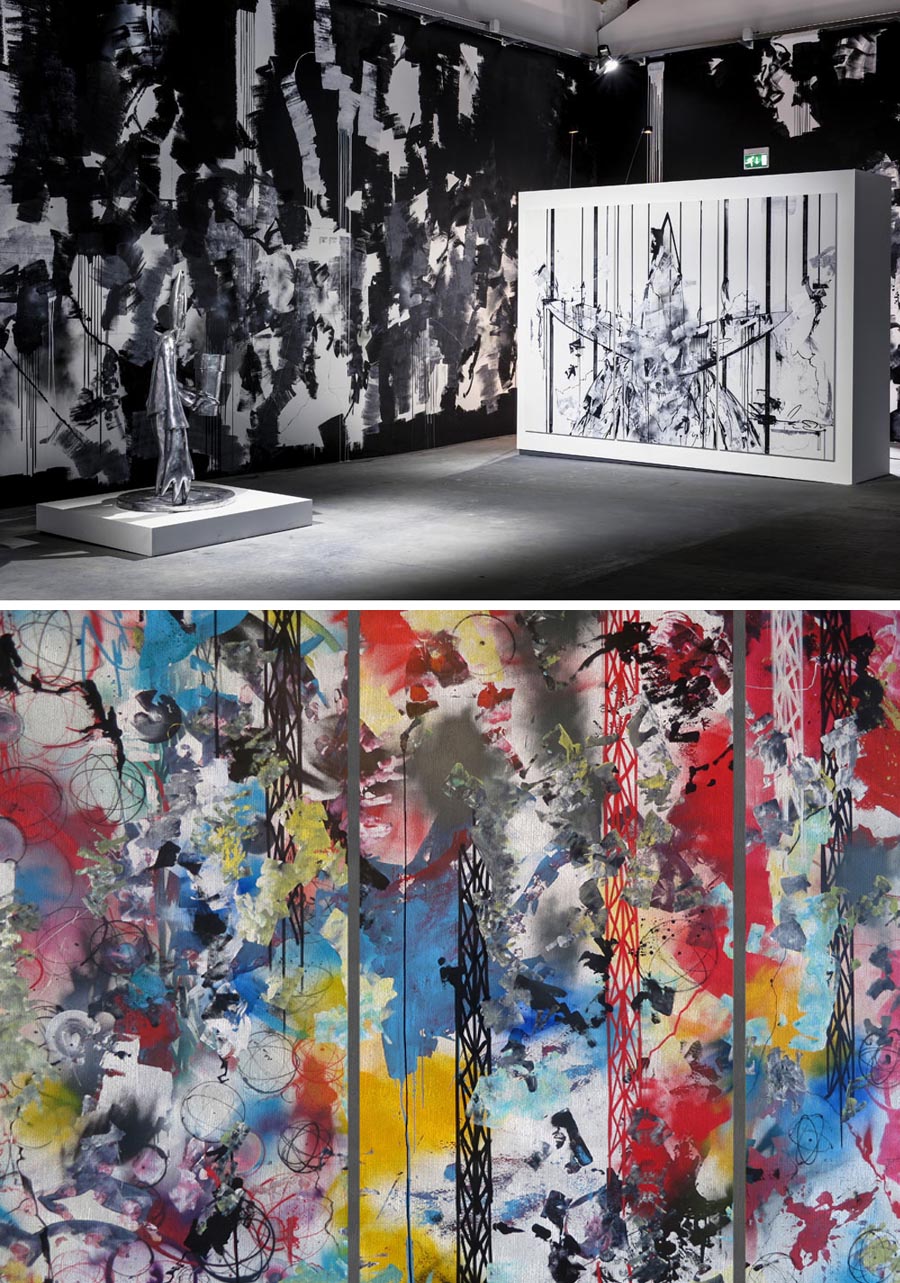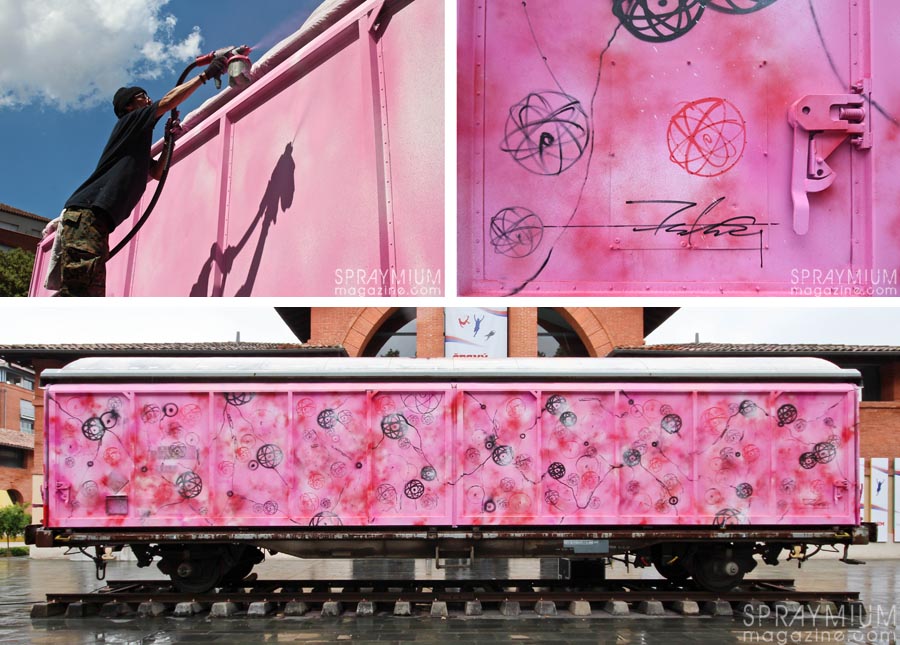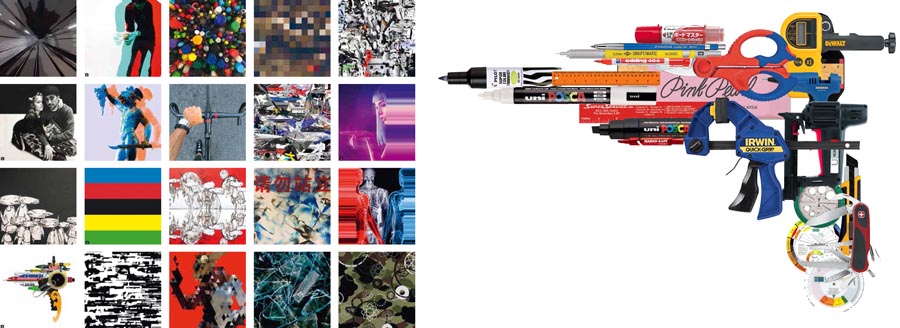Sa maîtrise de la bombe aérosol et ses échappées vers l’abstraction ont valu à Futura un statut de légende du graffiti. Mais derrière cette image publique, se tient un homme simple, dont l’histoire personnelle explique pour bonne part sa capacité à aller de l’avant. Portrait.
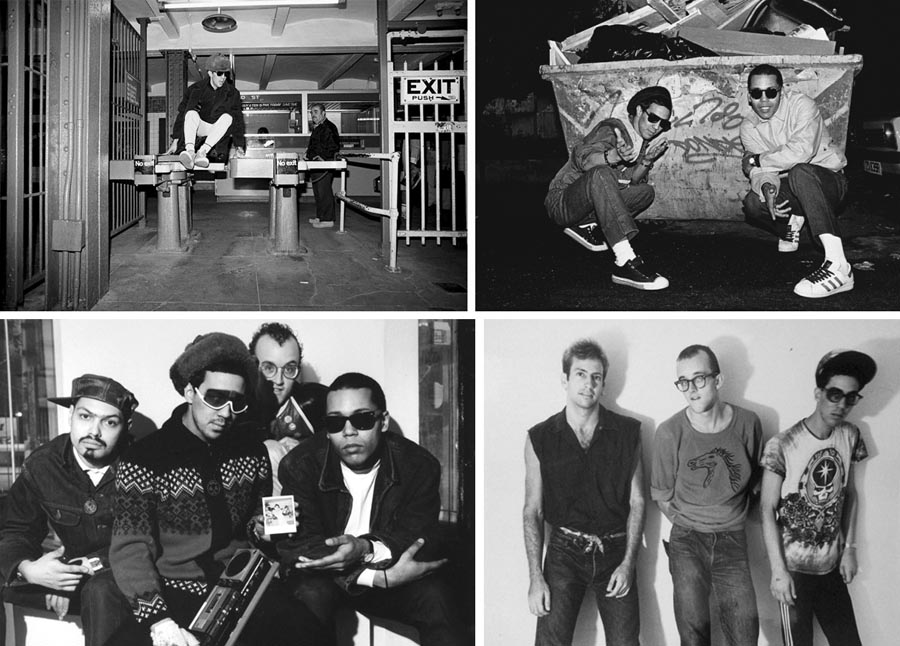
Futura, Dondi, Kano, Keith Haring, Kenny Scharf. Photos © Sophie Bramly, Janette Beckman, Eric Kroll, Barry Blinderman
S’il fallait, en complète contradiction avec le déploiement collectif et progressif du graffiti, n’en retenir qu’une toute petite poignée d’artistes, lesquels viendraient aussitôt à l’esprit ? Posez-vous la question, demandez autour de vous, et tendez l’oreille : il ne fait aucun doute que Futura serait du nombre. Depuis ses premiers trains à New York en 1972, et au gré d’un parcours en dent-de-scie où se croisent Jean-Michel Basquiat, Keith Haring, les Clash, Madonna, agnès b. ou Karl Lagerfeld, l’Américain de 62 ans – Leonard McGurr pour l’Etat-civil – a acquis un statut de légende vivante. Son aura se lit aussi bien dans la place que lui accordent les expositions et ouvrages sur l’art urbain (il figure notamment dans l’exposition Libres Figurations, en ce moment au Fonds Hélène et Edouard Leclerc à Landerneau) que dans ses nombreuses collaborations avec toutes sortes de marques et institutions (En 1984, il signait une campagne publicitaire pour la RATP. Plus récemment, il exposait chez Colette à Paris pour Chanel). Sans parler de la longue liste de ceux qui lui reconnaissent une influence décisive sur leur œuvre – dont Bando, Jonone ou Jef Aerosol, pour n’en citer que quelques-uns.
Cette part mythique tient sans doute d’abord à son nom lui-même et la fructueuse polysémie qu’il recèle. À la fois police de caractère et affirmation résolue d’une capacité à se projeter dans l’avenir, « Futura » synthétise à merveille quelques-uns des credos du writing – que ce soit sa sacralisation de l’alphabet et ses échos au vaste répertoire des écritures publiques (manchettes de journaux, logos publicitaires…), ou encore son allégeance spontanée à une ville régie par ses flux, reflet d’un monde en pleine accélération. Chez Leonard McGurr, cette aspiration visionnaire se dit jusque dans son pastiche des premiers pseudos : alors que Taki 183, Cay 161, Stay High 149 ou SuperKool 223 accolent à leur nom le numéro d’une rue, le jeune homme choisit de s’appeler Futura 2000. Une façon de projeter cette conquête spatiale qu’est le graffiti bien au-delà du block et de la ville elle-même, pour la nouer à la science-fiction version 2001, l’Odyssée de l’espace. De ses premiers trains à ses dernières publications sur son compte Instagram, l’avenir et les visions qu’il charrie n’ont jamais cessé de tenir lieu à Futura de programme artistique. D’où l’abandon du « 2000 » à l’orée du nouveau millénaire : pas question pour lui de renvoyer au passé.
Forcément, un tel blaze condamne à innover. « Son nom prédit déjà son style » souligne Magda Danysz, sa galeriste parisienne. Un style fondé en premier lieu sur une parfaite maîtrise de la bombe aérosol : « il en fait ce qu’il veut : un trait, un nuage, une ligne, un éclair », poursuit-elle. Admirateur de longue date de son travail, Mode 2 dit également son aisance et sa fluidité : « C’est l’homme qui a su saisir et immobiliser la spontanéité, note-t-il. Il est comme un genre de moine, de calligraphe japonais ou chinois qui reste devant une feuille blanche pendant des jours et des semaines, et d’un coup, exécute un geste qui est le bon… Les équilibres, les mouvements enregistrés, la pression avec laquelle la peinture est projetée sur la toile… : ça a l’air facile à reproduire mais personne n’y arrive ! »
Alors que l’essentiel des writers des années 1970 concentrent leurs efforts sur le travail du lettrage, Futura se distingue aussi en délaissant l’alphabet à la fin de la décennie pour un style abstrait, vaporeux, bientôt rehaussé de symboles personnels charriant aliens (le fameux pointman), atomes, grues ou codes barres. « Tout l’histoire du graffiti est très narcissique, explique-t-il. C’est : regardez-moi, je suis là ! ça m’a vite fatigué, parce que je ne suis pas ce genre de personne-là. J’avais plus que ça à offrir. C’est la raison pour laquelle j’ai cherché d’autres moyens d’exprimer ce que j’étais : en allant vers l’abstraction et en supprimant les lettres, le nom. D’une certaine manière, je me suis complètement éloigné du système que j’aimais tant… »
L’histoire personnelle de l’artiste est pour beaucoup dans cette échappée. Au cours de son adolescence, le jeune Lenny, comme l’appellent certains proches, subit une série d’électrochocs qui lui signifieront vite les termes de l’alternative : « aller de l’avant », selon son expression, ou se laisser choir. La première secousse a lieu alors qu’il a 15 ans : « je regardais mes parents et sentais bien que quelque chose clochait, raconte-t-il. Un jour, ma mère m’a révélé qu’elle n’était pas ma mère biologique, et mon père pas davantage. L’été suivant, je devenais Futura. Si je n’étais pas celui que je croyais être, alors je devais devenir quelqu’un d’autre. » Doué, le jeune homme se forge vite une solide réputation et se frotte à l’UGA, une association de graffeurs fondée par le sociologue Hugo Martinez. Mais vient bientôt le second électrochoc : au printemps 1973, en pleine fête du travail, il s’aventure dans un tunnel de métro avec Ali, ami et membre comme lui des Soul Artists. « Soudain, il y eut cet énorme éclair, et je vis ensuite une boule de feu embraser en un instant mon ami, rapportera-t-il dans une interview. Peinture défectueuse, étincelle mystérieuse ou destin distribuant les cartes… Ce qui est certain, c’est que ma vie ne serait plus jamais la même. » Leonard décide de raccrocher pour aller faire son service militaire – un choix cohérent pour un gosse élevé dans « les valeurs traditionnelles » et le culte paternel de la Seconde guerre mondiale. Sans doute cette expérience précoce explique-t-elle à la fois sa singularité et sa part visionnaire : dans la US Navy, Futura murit, voyage, et se voit propulsé dans un monde global, qu’il ne quittera plus.
Son retour à New York en 1979 et les années qui suivent scellent sa légende. Entre temps, le graffiti s’est singulièrement développé et l’évolution esthétique de Futura le prédispose à figurer en bonne place parmi les writers qui se frayent alors un chemin vers le monde de l’art. En 1980, à la galerie Fashion Moda ouverte en plein Bronx par Stefan Eins, il participe à l’invitation de Crash à GAS (Graffiti Art Success for America), qui inaugure à bien des égards l’engouement new-yorkais pour le graffiti. Au fil des expositions à PS1, au Mudd Club, etc., il rencontre Keith Haring, Jean-Michel Basquiat, et tout ce que « downtown » compte d’artistes et de branchés. Si sa maîtrise du geste le rapproche de Pollock, c’est à Kandinsky qu’on le compare. « Cette référence disait la sophistication de Futura, se souvient le photographe Henry Chalfant. Il avait été capable de s’éloigner des lettres pour faire écho au monde de l’art, et il était certainement au fait de l’abstraction moderniste, dont il a proposé sa propre version. »
Pour cocasse qu’elle ait semblé au jeune writer, la comparaison a un autre mérite : tout comme Kandinsky fut le peintre des correspondances entre couleurs, formes et sons, Futura tisse à l’époque des liens durables avec le monde musical. En 1981, il accompagne la tournée des Clash et seconde sur scène leurs incursions sur les terres fraîchement émergées du hip-hop. De cette rencontre, naît même un 45 tours : The escapades of Futura 2000. Au cours des années 1990, l’artiste crée aussi les pochettes iconiques de U.N.K.L.E, mythique collectif de hip-hop emmené par James Lavelle, le fondateur de la maison de disque Mo’Wax. L’aventure le mène au Japon, où il déclinera une série de toys conçus sur le modèle du Pointman avant d’y lancer sa propre marque de vêtements, Futura Laboratories.
Entre temps, Futura aura connu une traversée du désert publique : une fois passé l’engouement de downtown pour le graffiti, il se voit privé momentanément de toute perspective sérieuse de carrière. Il faudra l’engagement d’agnès b, qui lui loue un atelier à la fin des années 1980, puis de James Lavelle, pour le relancer. Mais ces aléas se doublent, en privé, d’une série d’heureux événements. En 1982, lors du New York City Rap Tour qui fait déferler le hip-hop sur la France, Lenny y rencontre Christine. Elle deviendra sa femme et portera ses deux enfants qui sont aujourd’hui, de l’aveu de l’artiste, sa plus grande fierté.
Ce hiatus entre vie publique et privée invite à faire la part du mythe et de l’homme, à tenter de débusquer Lenny derrière le « Kandinsky du graffiti ». Comme toute légende, celle de Futura risque en effet d’opacifier son parcours autant qu’elle l’éclaire. Elle a d’abord le défaut de lui conférer une image de star aux antipodes de sa personnalité, que beaucoup décrivent comme attentive, bonne, modeste et généreuse. « C‘est quelqu’un avec qui on passe un super bon moment, souligne Mode 2. Son côté abordable peut donner l’impression à beaucoup de gens que Futura leur appartient en quelque sorte. Ce serait bien qu’on lui accorde sa liberté de mouvement et sa liberté d’être lui-même. »
Futura lui-même le concède volontiers : s’il se dit chanceux d’avoir un tel parcours, il mesure aussi tout l’écart entre l’adulation dont il est l’objet et la simplicité de ses aspirations. « Je suis mal à l’aise avec ce statut de légende vivante, explique-t-il. Cette réputation est de trop pour moi. Si les gens savaient, ils verraient que ça m’importe beaucoup moins que mes enfants. » Pour un peu, il envierait presque Banksy, à qui son anonymat jalousement gardé permet de jouir d’une vie normale malgré sa célébrité. Au fond, l’ambition de Futura n’a rien à voir avec son image : « Je veux être connu comme une personne gentille », confesse-t-il simplement.
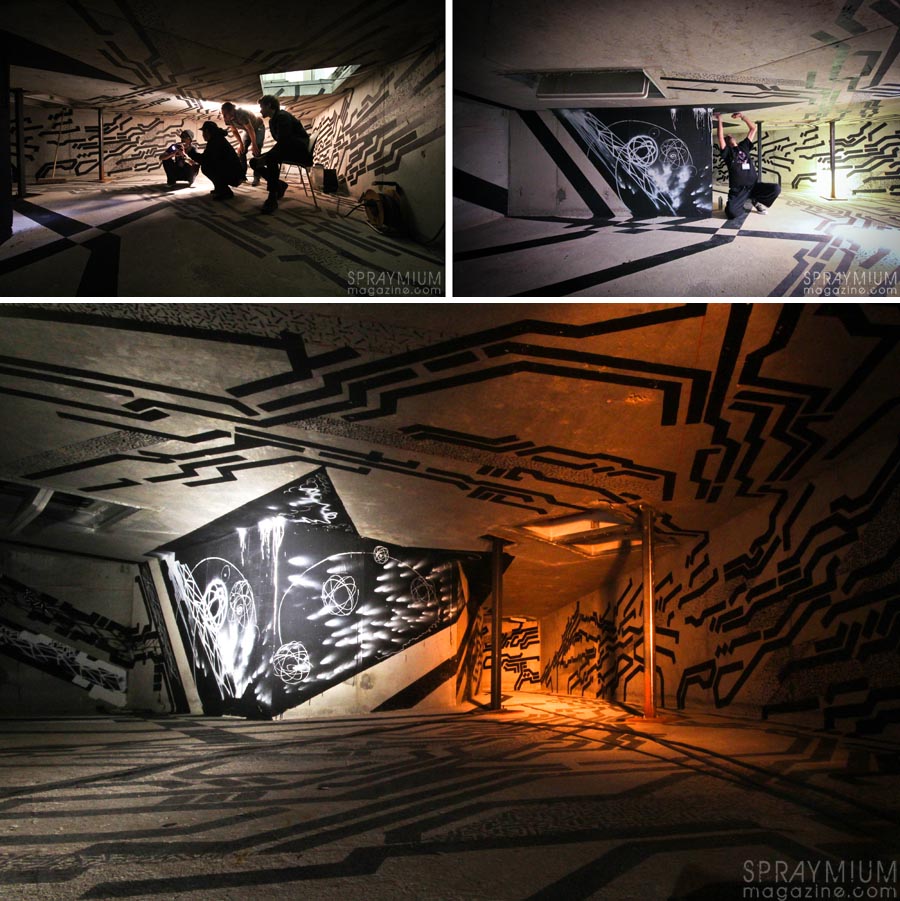
Dans les sous-sols du Palais de Tokyo avec Lek, Sowat & Hugo Vitrani – Paris 2014 – Photos © Nicolas Gzeley
Embarrassant pour l’homme, le mythe l’est aussi d’une certaine façon pour l’artiste, puisqu’il réduit un peu vite son œuvre à un futurisme abstrait jalonné de symboles personnels – dont l’atome et le pointman sont les expressions les plus iconiques. Or, son côté visionnaire excède très largement le champ du graffiti : il se lit aussi dans ses échappées dans le monde numérique – témoin son compte Instagram qui synthétise à coups de montages et de remix digitaux tout le climat de l’époque, de sa violence guerrière à sa fétichisation du corps des femmes. « Futura est un geek », estime Magda Danysz, qui rappelle que l’artiste fut l’un des premiers à se saisir d’Internet dans les années 1990, et à créer un site qui mériterait d’être exposé comme une œuvre à part entière. Et puis, si l’on en croit la galeriste, la légende de Futura a ceci de limitant qu’elle s’arrête au seuil des salles des ventes : « il est sous-coté alors que tout le monde est d’accord pour dire que c’est un élément clé dans l’histoire du graffiti, précise-t-elle. Les pièces mises sur le marché donnent des résultats très disparates, avec des hauts et des bas. »
De fait, dans le graffiti, la légende ne nourrit pas toujours son homme. Futura, qui le sait mieux que personne, accompagne et soutient aujourd’hui nombre d’artistes en devenir sur la scène street art. « J’aime rester en contact avec les jeunes, explique-t-il. Je suis connecté avec toute cette nouvelle énergie. » En attendant un livre monographique, prévu pour fin 2018 aux éditions Drago, c’est sans doute sa façon à lui de faire coïncider l’homme et la légende – d’être une « bonne personne » tout en continuant à aller de l’avant.
Texte de Stéphanie Lemoine
.
English version
His mastery of the spray paint and his journeys towards abstraction have given to Futura a status of graffiti legend. But beyond this public image lies a simple man whose personal history explains much of his capacity to move forwards. Portrait.
If you had, in complete contradiction with the collective and progressive spreading of graffiti, to choose a tiny handful of artists, who would immediately come to your mind ? Ask yourself, ask around, and listen carefully : no doubt Futura would be one of them. From his first trains in New York in 1972, and throughout a checkered route where he met Jean-Michel Basquiat, Keith Haring, Madonna, The Clash, agnès b. or Karl Lagerfeld, the 62-year-old American – Leonard McGurr, officially – has acquired a status of living legend. Proof of his aura lies in the exhibitions and books about urban art he appears in (he is, for instance, part of the exhibition Libres Figurations, currently at the Fonds Hélène et Edouard Leclerc in Landerneau) as well as in his numerous collaborations with all kind of brands and institutions (in 1984, he designed a publicity campaign for the RATP (T.N.: French public transport operator). More recently, he exhibited at “chez Colette” in Paris, for Chanel). Not to mention the long list of those who recognize a decisive influence on their work – among whom Jonone, Bando or Jef Aerosol, to name but a few.
This mythical part is certainly originated at first by his name itself and the fruitful polysemy it holds. Both font style and determined affirmation of an ability to anticipate the future, “Futura” greatly synthesises some of the credos of the writing – whether it be his sacralisation of the alphabet or his echoes to the vast repertory of the public writing (newspapers’ banner headlines, advertising logos…), or maybe his spontaneous allegiance to an overflowing city, symbol of a world that is accelerating so much. In Leonard McGurr, this visionary aspiration can be noted in his pastiche of the first pseudonyms : while Taki 183, Cay 161, Stay High 149, or SuperKool 223 append to their name the number of a street, the young man chose to name himself Futura 2000. A way to throw the kind of a space conquest that is also graffiti way above the block and the city itself, to tight it to the 2001: A Space Odyssey version of science fiction. From his first trains to his last Instagram posts, the future and the visions he carries have never ceased to be Futura’s artistic program. That is why he dropped the “2000” as the millenium started : no way for him to take us back to the past.
Of course, one expects the holder of a nickname like that to innovate. « His name already predicts his style », Magda Danysz states, his Parisian gallery manager. A style that is first founded on a perfect mastery of the paint spray: « he is able to do whatever he likes : a stroke, a cloud, a line, a lightning », she added. A longtime admirer of his work, Mode 2 also notes his ease and fluency : « He is the man who knew how to freeze spontaneity, he notes. He is like a kind of monk, a kind of Japanese or Chinese calligrapher who stands in front of a blank sheet for days and weeks, and all at once, executes a movement which is the one. The balances, the retained movements, the pressure with which the paint is projected on the canvas… : it looks easy to reproduce but nobody can ! »
While most of the writers of the 70s concentrate their efforts on the lettering, at the end of the decade Futura also stands out by leaving aside the alphabet for an abstract, aerial style, later enhanced with personal symbols like aliens (the renowned pointman), atoms, cranes or barcodes. « All the story of graffiti is very narcissistic, he explains. It’s like : look at me, I’m here ! I got quickly tired of that, because I’m not that kind of people. I had more to offer. That is the reason why I looked for other ways to express what I was : moving towards abstraction and removing the letters, the name. In a way, I got completely away from the system I liked so much… »
This distance he took is greatly due to the personal history of the artist. During his adolescence, young Lenny, as some close friends call him, went through a series of electroshocks that made him quickly understand what was the alternative: « move forwards », in his words, or drop it. The first jolt happened while he was 15 : « I looked at my parents and I could sense that something was wrong, he tells. One day, my mother revealed to me that she was not my biological mother, and that neither was my father. In the next summer, I became Futura. If I was not who I thought I was, then I had to become someone else. » Gifted, the young man quickly built himself a solid reputation and started to work with the UGA, an association of graffiti artists founded by the sociologue Hugo Martinez. But then came the second electroshock : in the spring of 1973, in the middle of the labour day, he ventured into a metro tunnel with his friend Ali, member as he was of the Soul Artists. « All of a sudden, there was this huge lightning, and I saw a fireball set my friend ablaze, he told later in an interview. Defective paint, mysterious spark or fate distributing the cards… What I know for sure is that my life will never be the same. » Leonard decided to hang up his boots and enter military service – a coherent choice for a kid raised with “traditional values” and with the paternal worship of WW2. This premature experience probably explains both his singularity and his visionary side : in the US Navy, Futura matures, travels, and is propulsed to a global world he will never leave again.
His return to New York in 1979 and the years that followed sealed the legend. In the meantime, graffiti had highly developed and the aesthetic evolution of Futura predisposed him to be well placed among the writers who fight their way to the world of art. In 1980, in the Fashion Moda gallery opened by Stefan Eins in the centre of the Bronx, he participated to Crash’s invitation to GAS (Graffiti Art Success for America), which indicated in many ways the new enthusiasm of New York for graffiti. He got the chance to meet Keith Haring, Jean Michel Basquiat and the cool artists and trendy people of downtown throughout exhibitions at PS1, at the Mudd Club and so on. His mastering of the gesture is close to Pollock, but he is usually being compared to Kandinsky. « This reference shows Futura’s sophistication, the photographer Henry Chalfant recalls. He had been able to get away from the letters in order to echo the world of art, and he was probably familiar with modernist abstraction, of which he gave his own version. » Even though the comparison seemed quite comical to the young writer, it has another merit : just like Kandinsky was the painter that made colors, forms and sounds correspond, Futura forged lasting links with the musical world. En 1981, he went on tour with The Clash and assisted them on stage on their first steps onto the newly discovered land of hip hop. From this meeting, a 45 is even born : The escapades of Futura 2000. Throughout the 1990s, the artist also created the iconic sleeves of U.N.K.L.E, legendary hip hop collective led by James Lavelle, the founder of Mo’Wax record company. The adventure took him to Japan, where he designed a series of toys conceived on the model of Pointman before launching his own clothing brand, Futura Laboratories.
Meanwhile, Futura was going through a long period of limbo : once the enthusiasm of downtown had passed, he was momentarily deprived of any career perspective. Agnès b.’s commitment – who rent him a studio at the end of the 1980s, and then James Lavelle’s were necessary to get back in the game. But these unexpected events came, on the other hand, with a series of happy events in his private life. In 1982, during the New York City Rap Tour which largely spread hip hop across France, Lenny met Christine. She became his wife and carried his two children who are today, as the artist says, his greatest pride.
That rift between public and private life invites us to distinguish the myth from the man, to try to flush out Lenny behind the “Kandinsky of graffiti”. Like every legend, Futura’s is likely to make his image appear less bright than it should. First of all, it has the flaw of making him come across as a star, whereas it is the opposite of his personality, which many describe as attentive, good, modest and generous. « He is someone with whom you have a great time, Mode 2 says. His approachable side may give many people the impression that they sort of own Futura. It would be good to give him his freedom of movement and his freedom of being himself. »
Futura himself grants that fact: even if if he considers himself lucky, he also realizes the gap between the adulation he is the object and the simplicity of his aspirations. « I am not comfortable with that status of living legend, he explains. This reputation is unnecessary to me. If people knew, they would see that it counts much less than my children to me. » He is on the brink of envying Banksy, whose anonymity jealously kept made it possible for him to enjoy a normal life despite his fame. Fundamentally, Futura’s ambition has nothing to do with his image: « I want to be know as a kind person », he simply admits.
The myth is embarrassing for the man, but in a way, it is also for the artist, because he reduces his work to an abstract futurism punctuated with personal symbols – among which the atom and pointman are the most iconic expressions. However, his visionary side largely exceeds the graffiti sphere: it is also evident in the digital world – the proof is in his Instagram account which summarises the temper of times, from its war violence to its fetichisation of the women’s bodies, through photomontages and digital remixes. « Futura is a geek », Magda Danysz reckons. She reminds us that the artist was one of the first to master the Internet in the 1990s, and to create a website that would deserve to be exhibited like a work in its own right. And what’s more, according to the gallery manager, the other limit of Futura’s legend is that it does not exist inside the salerooms : « he is not very popular despite the fact that everybody agrees to say he is a key element in graffiti history, she precises. The pieces placed on the market give very disparate results, with ups and downs ».
Indeed, with graffiti, being a legend does not bring you wealth. Futura knows it better than anybody, that is why he guides and supports many budding artists on the street art scene. « I like staying in touch with the young people. I am connected to all this new energy ». While he is waiting for a monographic book, scheduled to be published by Drago at the end of 2018, it is probably his way of making the man match with the legend – of being a “kind person” while keeping moving forwards.
